HIGH-ALTITUDE FORCED ENTRY
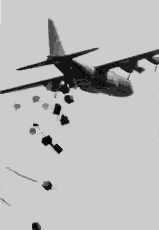
The North Vietnamese Army has surrounded the city with tanks and infantry, but the ARVN Paratroopers and Rangers are holding out--their "Bostogne". But they are running out of ammunition as U.S. AID advisor John Paul Vann is flying around the country rallying the allies and coordinating B-52 strikes to stop the invasion. Its Giap, victor at Dien Bien Phu, the NVA's military genius versus John Paul Vann, passed over retired U.S. Army Lieutenant Colonel who refuses to give up. An U.S. Army officer from that era writes:
I was surfing around several Vietnam era sites and found this item. I was the Airdrop Opns Officer for the 549th Quartermaster Company (Aerial Delivery) from '70-'73. We rigged those CDS loads! I recall being called into 'Mother's Place?', the opns area at TSN, the night the last C-130 was shot down at An Loc after low level drop. The COL, whose name I cannot recall, informed CW4 XXXX and me that we had to come up
with a high altitude load if support was to continue. What followed was the 12,000 ft AGL hi-velocity CDS execution. We initially used 22-ft extraction chutes, followed by newer 26-ft ring slots. I have extensive records of our drops, by DZ location and date. The 549th was stationed in Okinawa and was TDY attached to MACV Team 118. The same hi-v operation transitioned to Utapao where 374th and 314th TAW rotated in
support of Operation SCOOT, Support Cambodia Out Of Thailand, from '73 until its '75 end. Extensive Army support for rigging both ammunition and rice drops originated there with drops all over Cambodia. I was the Phnom Penh resident airdrop officer in '74 while assigned to MEDTC, Materiel Equipment Delivery Team Cambodia. A good friend, XXXXXXX,
ran the ammo supply operation in Thailand - he's got plenty of details on that piece. Political concern for having USAF crews over Cambodian airspace in mid-'74 resulted in Bird Airways being given a contract for flight services - another story in itself. Maybe somebody out there from MACTHAI can amplify this aspect of C-130 operations in the last days of SEA airlift."
"COMMANDO VAULT had some by-products in that the radar-guided deliveries led to similar techniques being developed for the delivery of cargo. The GRADS method proved to be a God-send during the siege of An Loc in the spring of 1972 as it allowed USAF C-130 crews to drop from altitudes above the range of the antiaircraft guns and SA-7 missiles that were
being used by the North Vietnamese. Using special Rigging techniques allowing high-velocity drops from high altitudes, the GRADS crews were able to achieve the same accuracy with cargo bundles that they were attaining with the bombs.
THE THREAT TODAY--AND ITS SOLUTIONS

While SAMs are deadly, they are hardly the only threat that must be faced by aircraft operating in close proximity to an enemy force, particularly those operating at altitudes below 2,000 feet.
Ever since World War II combat aircrew members have known that the PRIMARY threat to aircraft operating at low altitudes is small arms fire. This was true in World War II, it was true in Korea, it was true in Vietnam, Desert Storm and it will be true in the next war. While shoulder-fired SAMs allow small units to have a more effective weapon against low-flying aircraft, this does not mean they are the only threat. In Vietnam a crew-served automatic weapon of .50 or .51-caliber HMG was considered to be "heavy" antiaircraft by U.S. Army helicopters and other aircraft operating exclusively in South Vietnam. In the out-of-country war such weapons were considered "small potatoes", but this was because jet strike aircraft typically did not go below 2,000 feet, which is the effective altitude of small arms fire up to and including .50 caliber HMGs. Larger caliber weapons such as 23mm and 37mm are effective up to about 10,000 feet, while larger calibers can reach up into the crusing flight Levels.
Airlift aircraft, whether C-130s, C-17s, C-141s, C-5s or helicopters must, by necessity, operate at very low altitudes during LVAD CDS and current static-line mass tactical (airdrop) Airborne and Airland operations. As such, they are exposed to an environment in which every type of weapon can be a threat. For example, during the evacuation of Kham Duc on May 12, 1968 in the Vietnam War the attacking NVA forces were not equipped with antiaircraft as such, other than a few crew-served weapons. Yet they managed to shoot down no less than ten airplanes and helicopters, including two C-130s. One C-130 was brought down by the combined fire of a pair of .50-caliber heavy machineguns which may have been captured from the Americans earlier in the day while the other was brought down by AK-47 fire. Consider this - a company of enemy troops equipped with AKMs ("AK-47s") is capable of putting a lot of bullets into the air, as many as 4,000 rounds if each is equipped with a 40-round magazine. An unarmored airlift airplane struck by even a quarter of those rounds is going to be in very big trouble.
Another factor that must be considered is that a large infantry force supported by crew served weapons is capable of putting up a literal wall of fire, as happened during the seige of An Loc in the spring of 1972. Bear in mind that the American C-130 and Vietnamese C-123 crews charged with resupplying the garrison at An Loc was completely INEFFECTIVE until the development of accurate high altitude drop methods that allowed deliveries from above the effective range of the antiaircraft and small arms fire that was present on the ground. Three USAF C-130Es and (at least) two VNAF C-123s were shot down at An Loc during the low-level drops in which the tonnage actually retrieved by those on the ground was minuscle. In short, the battle of An Loc ushered in a new dimension in airlift, yet very little attention seems to be paid to this fact by those responsible for modern airlift planning.
What am I saying? Well, for one thing "250 knots at 250 feet" is not always an effective defense against ground fire. While a single airplane will probably be overhead and gone in such a situation, any others that follow will be susceptible to ground fire, regardless of whether the mission is flown at night or in the daytime. At the same time, if the defenders have any indication that the low-flying aircraft are on their way - and they likely will - barrage tactics with automatic weapons can cause tremendous harm to an Airdrop or Airland formation, whether large or small.
Those who have not read it should obtain a copy of the Project CHECO Southeast Asia Report, Airlift to Besieged Areas, 7 April-31 August 1972. The following are some excerpts from the "Lessons Learned."
"1. The AAA/SAM threat must influence heavily the altitude profile which will be flown.
2. The use of various low-level evasive tactics and the element of surprise when an drop zone is surrounded by strong enemy forces are of minimal value.
3. The use of suppressing fire from other airborne fighter and gunship aircraft is also only marginally effective. When a DZ is totally surrounded by an enemy who is well dug-in, it is near impossible to silence every gun.
4. Based on the above circumtances, low-altitude CDS aerial drops are deemed inadvisable. High altitude drops should be strongly considered as THE PRIMARY METHOD TO BE TRAINED AND DEVELOPED FOR FUTURE COMBAT AIRDROPS."
Those words were written by Major G.E. Lange, the JTF Tactical Airlift Planner with 7AF/MAC-DO.

USAF and Army studies indicate there are two ways to evade enemy air defenses: drop really low (below 250-500 feet) or VERY HIGH. This includes EVERY item of Airborne force equipment under 500 feet, not just Paratroopers. Like the awesome GRADS drops used in the Vietnam war to save the Soldiers at An Loc to the high-altitude drops of food supplies to the starving citizens of Bosnia, U.S. Army Air Delivery specialists have perfected this techniue for equipment deliveries. In fact, U.S. Army Natick Labs is developing a ram-air parachute (RAP) that flies by remote control fom 20 miles away at high altitude that can deliver 42,000 pound platforms with armored vehicles, called GPADS-Heavy. We already have GPADS-Light. We are even working on raps with better gide ratios for even longer stand-off insertions. The question is who is going to drive them?
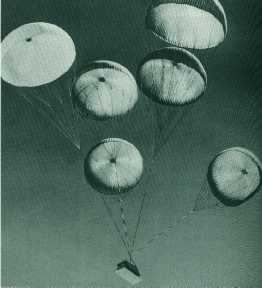
U.S. Army Airborne's BMD: the M113A3 Gavin under canopy
We could develop special seats and have Paratroopers sit inside the M113A3 Gavin as it is high-velocity airdropped like the Russians do with their BMD-3 AFVs. It is doubtful that safety conscious Americans are willing to do this. The next technque available is Military Free-Fall (MFF) techniques using a stable body position to descend rapidly from high altitudes as used by Special Forces. This is the immediate answer and a Company of 82nd Airborne Paratroopers in each Ready Brigade should be designated and trained at once to do high altitude mass tactical jumps using current MC-4 RAPs to seize drop zones and knock out enemy air defenses for the low-altitude mass tactical jump of the remaining Brigades/Regimental Combat Teams to proceed.
Current U.S. Stabilized Body Position Free-Fall HALO Jump
This will be dicey since the RAP has a 25 mph forward thrust and the chances of collisions great, but we need a high altitude forced entry capability to accompany guided RAP systems as well as to clear the enemy for low-altitude jumps to occur.
RUSSIAN AIRBORNE ALREADY HAS HIGH-ALTITUDE MASS TAC CAPABILITY: PUTS U.S. AIRBORNE TO SHAME!

EXCLUSIVE! See video clips of Polish and Russian Paratroopers jumping by drogue chutes followed by ASU-57 Assault Guns and BMD infantry fighting vehicles:
www.combatreform.org/polishairbornedrogueparachutejump.wmv
www.youtube.com/watch?v=bsh2tlIrUks
www.combatreform.org/russianairbornejumpwithasu57tafv.wmv
www.youtube.com/watch?v=A53TSrsWwJM
More Russian Airborne Videos!
www.combatreform.org/russiandroguechuteandbmdairdrop.wmv
www.youtube.com/watch?v=_hrvgYEI90c
www.combatreform.org/russianairbornebmd1inaction.wmv
www.youtube.com/watch?v=IUF4GVszsCQ
Note:
1. they jump in front of jet engines because they use drogue chutes not static lines and D-bags; as BMD goes out rear ramp they are jumping in front fuselage to land closer together
2. they can fire AKMs on way down under canopy (we can, too with M4 5.56mm carbines)
3. they have men IN the BMD to speed de-rig and placement into action
4. what they can do with BMD we can do even better with M113 Gavins/M8 Buford/Thunderbolts to give Paratroopers armored mobility/firepower/protection
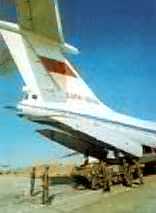
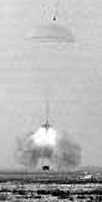
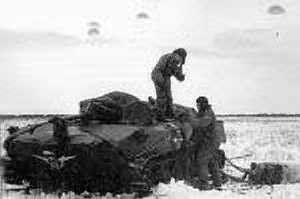
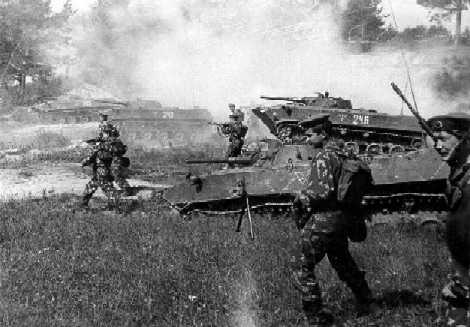
The United States Army's Airborne forces are the only units that can provide this nation with the capability of rapidly projecting combat power, anywhere in the world, in the defense of vital interests. However, unless this force is provided significantly more firepower, mobility and survivability, while remaining strategically deployable, the many Third World 21st Century threat weapons may prohibits its use. Non-use is not an option: world moves by the speed of the AIR. A well-rounded U.S. Airborne with a combination of foot/human powered vehicle, helicopter and light AFV mobility means would be best. As Guderian said after the fall of France in 1940; "It was the TRACK not the tank that won for us".
What we need as the final solution--a round low-altitude canopy to deter collisions that has delayed opening and a drogue chute to stabilize the Paratrooper's body position without need of learning the laborous MFF techniques--like the Russian D-7 parachutes do. A "T-21H" derivative of a round canopy and reserve integral to the back---needed to improve low-altitude Airborne assaults. Basically a High Velocity Airdrop technique for personnel. This way even if the Close Air Support (CAS) and Gunship force fails to get every MANPADS launcher, the main body would still arrive from aircraft too high for the enemy to do anything about it.
In fact, U.S. Army Rangers have already done High-Altitude Mass Tactical jumps:
"When World War II ended, the Rangers were disbanded, just as they had been after other conflicts in America's past. In 1950, the Army Chief of Staff selected Colonel John Gibson Van Houton to create a Ranger training program at Ft. Benning, Georgia. The goal of the training was to create a headquarters company and four Ranger infantry companies (Airborne).
As many as 5,000 Soldiers from the 82nd Airborne Division alone volunteered for the 6 weeks long course. Teaching amphibious and airborne infiltration, sabotage, demolition's, and familiarization with U.S. and foreign weapons, the program was intended to create highly skilled Soldiers capable of moving "40-50 miles, cross country, in 12 to 18 hours, depending on the terrain.
The graduates of the school were organized into eight companies, each of which was attached to a conventional infantry division. The 1st, 2nd, and 4th Ranger companies finished the first cycle on November 13, 1950. 3rd company remained at Ft. Benning to train the remaining 5th, 6th, 7th, and 8th companies. The 2nd Ranger company was made up entirely of black volunteers who were experienced troopers from the 555th (Triple Nickel) Infantry Regiment (Airborne).
Throughout the winter of 1950 and the spring of 1951, the Rangers went into battle. They were nomadic warriors, attached first to one regiment, then another. they performed "out front" work: scouting, patrols, raids, ambushes, spearheading assaults, and as counterattack forces to restore lost positions. The 1st Ranger Infantry Company (Airborne) once went nine miles behind enemy lines and destroyed the headquarters of the 12th North Korean Division. Two North Korean Regiments fled from the area as a result. The 2nd and 4th Ranger Companies made a combat jump at Munsang-ni and were seen moving north of the 38th parallel by reporters for Life magazine. The Rangers of the 4th company executed a daring over-water raid at Hwachon Dam. The 3rd Ranger company had the motto; "die, bastard, die." The 5th Ranger company performed brilliantly during the Chinese "5th Phase offensive." The Ranger company commander held the line with Ranger sergeants commanding other line infantry units. The 8th Ranger Company (known as the "Devils") would kill 70 Chinese soldiers in an encounter with two Chinese reconnaissance companies. The 6th Ranger Infantry Company (Airborne) would later be moved to Europe because of growing concern over Communist Bloc interest in expanding to the west. There those Rangers would be the first Army unit to conduct a mass, tactical, free-fall jump."
Two Possible Gliding Technologies


The superb 007 film, "Die another Day" shows James Bond and Jinx infiltrating into North Korea using the PSST gliding sled after exiting out the rear ramp of a CH-47 Chinook helicopter. The problem as you will remember is the glider sled has to be discarded when the main parachute is deployed to land.

The recent strap-on HALO "bat wings" can be kept on the Paratrooper for re-use after he deploys a regular RAP to make a controlled, soft landing.
London Sunday Times May 28, 2006The ability to high altitude force entry is a needed tool in the Airborne force's arsenal---vital for America to execute Airborne warfare.Batman's Wings For Gliding Troops
By Peter Almond
MILITARY scientists have designed a Batman-style set of wings to enable paratroopers to glide up to 120 miles into enemy territory.
The device enables the caped Soldiers to be dropped outside hostile airspace from altitudes of up to 30,000ft and infiltrate enemy lines without being detected by radar.
The wings, unveiled last week, are being tested by their manufacturer and are intended to be ready for use next year by German special forces parachutists.
"Parachutists can penetrate into areas that are difficult to reach without their transport planes having to fly into a danger zone," said a spokesman for ESG, manufacturer of the new mono-wing.
"At the same time, tracing this almost 100% silent system using air or ground-based radar systems is extremely difficult."
In practice, a reserve parachute is carried for safety.
The guidance, oxygen and stablisation systems for the wing are being finished and studies have begun on a powered version which will use small turbo-jets.
"The system is reportedly 100% silent and extremely difficult to track by air or ground-based radar systems," said Peter Felstead, editor of Jane's Defence Weekly.
"The new wing will also reduce the impact of wind conditions on the jumper and allow operatives to travel up to 40 kilometres carrying equipment loads of around 100 kilograms."
According to ESG, the wing is a development of a ram-air parachute system in use with the German armed forces since 2003. Ram-air parachutes, also used by the SAS and US special forces, have two layers of fabric which fill with air and become highly controllable airfoil shapes.
While ESG says German special forces as well as the country's GSG9 counter- terrorist unit have expressed interest, British special forces experts remain skeptical.
"High altitude, high opening (HAHO) jumps may keep the plane out of harm's way but they are very difficult for the jumper," said one recently retired senior SAS officer.
"His parachute opens almost immediately and he has to control it for a very long time. He is buffeted by winds, he's very cold, he's breathing oxygen and he has to navigate and communicate with the rest of his team.
"I can't think of an operational HAHO we've done, and I don't even think we've done an operational HALO (high altitude, low opening) since Oman in 1970."
On that occasion an SAS trooper, Lance-Corporal Paul Reddy, died when his parachute failed to open properly after free-falling from 11,000 ft.
The most recent high altitude jump on operations was carried out by NATO special forces in Bosnia in 2001 - reportedly in an attempt to capture a high-ranking alleged Serbian war criminal.
The Ministry of Defence declined to comment on special forces equipment but said: "We continually look to improve the capability of our armed forces and in doing so we keep a close eye on technological developments all over the world."
Private Murphy's View

RETURN TO U.S. ARMY AIRBORNE EQUIPMENT SHOP